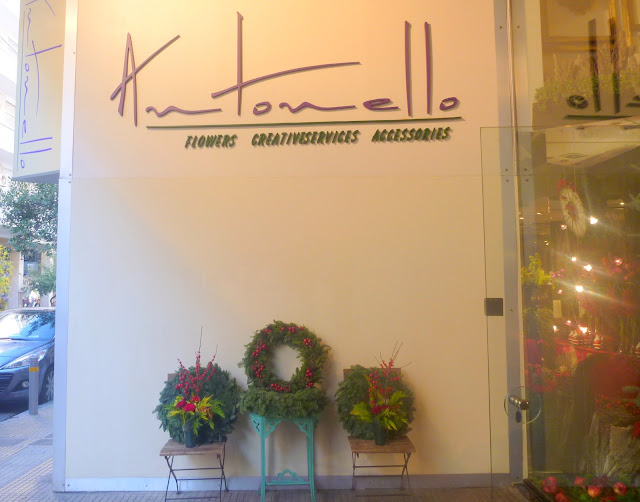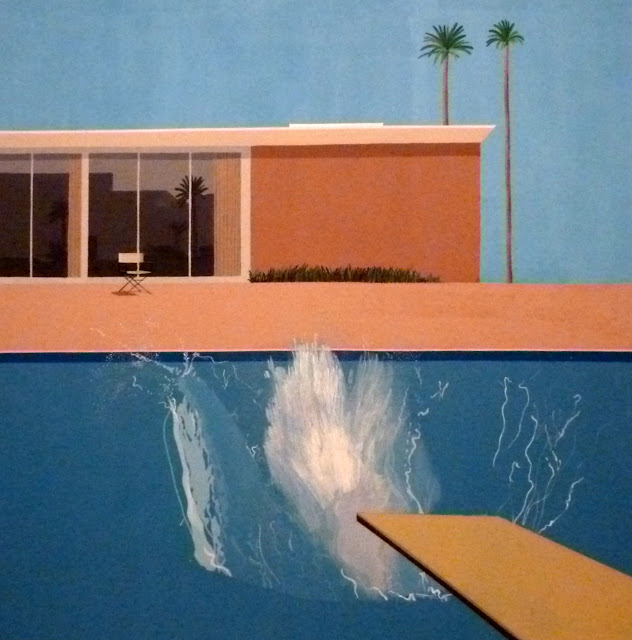A Bigger Splash - Painting after Performance, Tate Modern.
This exhibition looks at the dynamic relationship between painting and performance since the 1950s and at how experiments in performance have expanded the possibilities for contemporary painting. Attempting to look at the as yet unexplored relationship between so-called traditional and new media, the exhibition looks towards performative environments in which painting becomes a form of stage-setting that is continuous with the painted body of the artist or performer, de-stabilising the conventional set-up of making or viewing.
In this first half of the exhibition artists look at ways in which the act of applying paint to canvas can itself be a form of performance, as well as the reinvention of painting as a collaborative or ritualistic action. In the immediate post war period conventions of painting were broken down and pictoriality and composition were replaced with slashed, dripped upon, shot-at or cut-up canvases: new 'arenas for action'. In the 1970s artists used the body as a surface for painting, while some working largely from feminist or queer perspectives re-thought painting in new media as costume, make-up or drag so that painting became part of expanded art practices.
Room 1
Two major post-war paintings where each artist proposes a different approach to painting. For Pollock, the canvas is itself a field of action, a record of the artist's movements in actual space and time. In Hockney's case, the painting becomes an artificial backdrop that opens up a theatrical space, implying the viewer's entrance into its fictional world.
A Bigger Splash, David Hockney, 1967
Though the burst of water in the pool resembles a spontaneous splatter of paint, the intricate layers of white acrylic took Hockney two weeks to construct. This painting emphasises a stylised theatricality that blurs fact and fiction. The spray of water is not the spontaneous splatter that it at first appears to be, but an intricately constructed mess of hatched, dribbled acrylic so that the splash is not a splash but a painstaking and poetic deceit and as such it is an incorporation into representational painting of a deliberate stylistic rebuff to American abstract expressionism's dominance at the time. During that time Hockney got involved in an elaborate defense of figurative over abstract art in battle with the adherents of Clement Greenberg. Careful to conceal the passage of its creation, the illusion of splashed water and of splashed paint implies performativity, but unlike the gestural brush mark or drip, it belies the activity of the hand of its maker.

Jackson Pollock: Summertime 9A, 1948 (oil paint, enamel paint and commercial paint on canvas)
Pollock developed a style drawing attention to the painting as an object, one that registered the artist's process and was not concerned with illusionist space.
Summertime 9A is displayed on the floor in this exhibition just as it was layed out on the floor in Pollock's studio whilst it was being made. His technique of dripping and pouring paint as he stepped around the canvas led the critic Harold Rosenberg to argue that Pollock had recast painting as an
'arena in which to act. What was to go on the canvas was not a picture but an event'.
The intricate layers of line and colour that build up can be seen as literal tracks of his dance-like movements across a canvas within a traceable period of time. Paul Shimmel noted that Pollock 'transformed the artist's role from that of bystander outside of the canvas to that of an actor whose very actions were its subject'.
Pollock stated:
'A method of painting is a natural growth out of a need. I want to express my feelings rather than illustrate them. Technique is just a means of arriving at a statement'.
Looking at the film that accompanied the painting, Pollock appears to be internally driven to move back and forth with a certain rythm, to make particular decisions about the colours of the paint, about when to start and when to stop. This form of abstraction could consequently be tied to the romantic notion that a pure, unmediated expression of inner life is somehow possible - the act of creating is itself the principle factor, over and above symbolic or realistic representation.
Looking closer.
Room 2 - action painting
Action painting with its dramatic gestural marks and attack on the traditional limits of the canvas, can be seen as part of a post-war attempt by artists to destroy existing cultural templates and begin again from scratch. In the wake of Pollock's meteoric rise to international fame, artists in the 50s and early 60s recognised the new role played by photographs of the artist at work. Such images underlined the increasing importance of process, and provided valuable publicity in a media-savvy world.
Pinot Gallizio, Industrial Painting, 1958 (monoprinted acrylic and oil paint, typographic ink andsolvent on canvas)
Gallizio was an early member of the Situationist International, an avant-garde group that attempted to analyze and subvert the capitalist commodification of daily life. Galizio's industrial painting adapted mechanised manufacturing techniques to challenge established models for the production and distribution of art. The paint was applied onto long rolls of canvas by a team of assistants using a 'low-painting machine' so that the result was mass-produced but also unique. Gallizio would then cut off sections to be sold. The resulting paintings would be displayed for sale like dress fabric and demonstrated by live models.
Looking closer
Kazuo Shiraga, Chizensei Konseimao (Nature Planet), 1960 (oil paint on canvas)
Shiraga's technique emphasizes the process of painting rather than the finished product, so that the act of painting sometimes became a theatrical performance, enacted for TV cameras or live audiences. He presented an action which involved firing arrows at a white canvas. In the late 1950s Shiraga developed a technique of swinging from a rope and painting with his feet.
Shozo Shimamoto, Holes, Ana, 1953 (foil paper and oil paint on paper mounted on wood)
Shimamoto emphasized the art-making process often blurring the distinction between creative and destruction actions. The Holes series explored the action of piercing the surface of a painting in a ritualistic and ordered manner. He also made paintings by firing a canon at a canvas or hurling glass bottles filled with pigment that would mark the canvas as they smashed against it. The dramatic act of creation was presented as being as significant as the finished painting.
Looking closer.
Nikki de Saint Phalle, Shooting Picture, Tirage, 1961 (plaster, paint, string, polythene and wire on wood)
De Saint Phalle filled polythene bags with paint and enclosed them within layers of plaster against a blockboard backing. The artist would then shoot at these constructions, releasing the paint. The process of making became as important as the finished work, and was regularly photographed and filmed with Saint Phalle wearing a white jumpsuit.
Nikki de Saint Phalle at work.
Room 3, Viennese Actionism
This group of artists regarded their highly provocative bodily actions as a new, living form of painting and much of this work was staged solely for the camera, often intended for publication rather than for a live audience. Growing up with the memory of WWII, these Austrian artists were reacting partly against what they saw as the political oppression and social hypocricy of their country and saw their actions as a kind of catharsis.
Hermann Nitsch, Poured Painting, Schuttbild, 1963 (oil paint on canvas)
Gunter Brus, Untitled, 1960
Gunter Brus, Self-Painting, 1964
Room 5, Transformer
The idea of painting as an agent of transformation is developed here around themes of identity. Much of the work is from the 1970s, a decade that challenged stereotypical ideas of beauty and gender. Drawing upon make-up and drag, artists explored the convergence between new media and how it might reinvent painting, via developments in feminist and queer politics. Such approaches re-cast painting as a transformative medium.
Helena Almeida, Inhabited Painting, 1975
Almeida created a series of performative photographs titled Inhabited Painting in Lisbon in 1975. Within each black and white photograph Almeida is posted, paintbrush in hand, making her mark in thick acrylic blue paint. The brushstrokes complete the action that her photographic self made. By combining photography, painting and performance she explores the formal tension between the flatness of the painting and the illusory space of the photograph.
'I was my work. There was no distinction between the canvas, the dimension of the canvas, and me. There was no distinction between the inside or the outside. My inner self was my outer self and my outer self was my inner self'.
Cindy Sherman, Untitled A, 1975
Cindy Sherman has developed a vast range of personae through costume and make-up creating a cast of characters from her own face and body. Her personae range from feminine ideals to exaggerated archetypes and shift between naturalism, abstracted grotesquerie, clowning and glamour. She is associated with the 'Pictures' generation, a group of artists using minimalist and conceptual practices to examine photographic or media imagery in the late 1970s in New York. Made at a time when photography as an art form was being reconnsidered, the images examine how women are represented in popular culture.
Cindy Sherman, Untitled, 1983
Her work explores role play in studio portraits based on people seen on the street, and often involving make-up and costume to explore issues of gender, class, masquerade and fiction.
Zsuzsanna Ujj, With a Throne, 1986
Since the 1980s Ujj has worked with performance and poetry to critique cultural constructions of female sexuality. Emerging from a situation in Hungary where most art institutions were state controlled, and being self-taught, Ujj turned to her own body as the basis of her work, painting and photographing it in anonymous settings to appear abstracted and distorted.
In Untitled 1986, a series of black and white photographs taken over four days, Ujj, alone, in an anonymous space, adopts a number of disquieting poses: her naked body, crudely painted to resemble a skeleton, transforms the traditionally passive female nude into a site of physical conflict. As she gazes menacingly beyond the picture's frame, the viewer is directly inplicated as a voyeur of a scene that oscillates between vulnerability and violence. This image of primitive ritual overturns alluring images of women.


















































